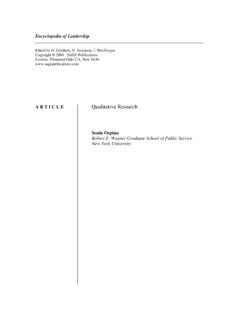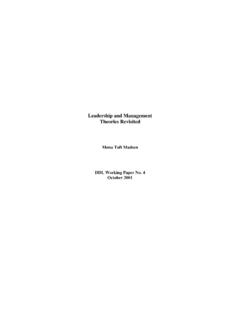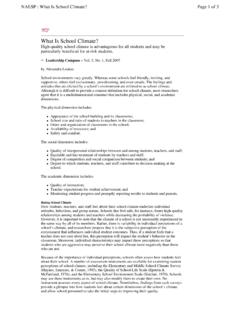Transcription of The Importance of Trust in Leadership - ed
1 Research Management Review, Volume 20, Number 1 (2014) 1 The Importance of Trust in Leadership David L. Mineo DL Mineo Consulting In a Harvard Business Review article, Robert F. Hurley cited a 2002 survey that he had conducted of 450 executives. His findings showed that 69% of the respondents agreed with the statement, I just don t know who to Trust anymore (Hurley, 2006). Recently on Face the Nation , Bob Schieffer stated, When the United States takes a position in the world and then goes back on its word, the world is left in a very dangerous place (Schieffer, 2013). When a leader speaks it is important to be able to have confidence in the honesty, truthfulness, and sincerity of the words.
2 This is the essence of Trust . If one looks at the different philosophies on Leadership , each espouses various attributes that are essential to create a bond between the leader and the followers who are being led. This article is intended to focus on how the bond is created that provides the leader with the vehicle for success. Trust is the glue that binds the leader to her/his followers and provides the capacity for organizational and Leadership success. This article is intended to focus on how the bond is created that provides the leader with the vehicle for success. Trust is the glue which binds the leader to her/his followers and provides the capacity for organizational and Leadership success.
3 In reviewing the multitude of Leadership theories and in discussing the volumes of attributes, steps, and other individual elements that make up each theory, there are many common items. For example, thirty-three attributes that form the basis of Leadership development have been Research Management Review, Volume 20, Number 1 (2014) 2 suggested by the Center for Creative Leadership s Leadership development model. And other programs provide their own premises upon which a Leadership program is grounded. In reviewing the theory around another program, the Everything DiSC Work of Leaders Assessment by Insight Publishing (A Wiley brand), there are three broad activities that make up their model: Vision, Alignment, and Execution.
4 This model, like most other models, speaks to multiple activities, including creating clarity, creating a sense of urgency around Leadership undertakings, providing the opportunity for dialogue, and being inspirational. All of these are admirable actions but can they happen without Trust in the leader who is attempting to champion the philosophies of Vision, Alignment and Execution or any other set of Leadership attributes?1 ..the foundation of a great workplace is created by organizational credibility, respect and fairness which form the foundation of Trust . In looking at the Dimensions of a Great Workplace model, the foundation of a great workplace is created by organizational credibility, respect and fairness, which form the foundation of Trust .
5 These elements are further broken down as follows: (1) credibility, which includes open and accessible communications, organizational competence in coordinating human and material resources, and integrity in carrying out vision with consistency; (2) respect, which includes supporting professional development and showing appreciation, collaboration with employees in relevant decisions, and caring for employees as individuals with personal lives; and (3) fairness, which includes balanced treatment for all in terms of rewards, absence of favoritism in hiring and promotions, and lack of discrimination and process for appeals. This model is literally grounded in the foundation of Trust ; the Great Workplaces Institute is the organization that conducts the annual Great Places to Work survey cited in major publications (Burchell & Robin, 2011).
6 As someone who has dealt with individuals in Leadership positions for over forty years in academia, government, and the private sector, it is incredible how many individuals want immediate returns as opposed to taking the time to build Trust and undertaking activities that allow that Trust to flourish. An example of this occurred when a new director came into an organization. She immediately started going to some funded centers and talked about new directions in which she wanted these organizations to move and told them as they moved in those directions that federal funding would be provided. Unfortunately, Research Management Review, Volume 20, Number 1 (2014) 3 funding was not available to do the multitude of things she wanted done, as is normal in the current research environment.
7 The outcome was that over a very short time she lost the Trust of these organizations and their Leadership . They continued to move in the directions she dictated but at an extremely cautious pace. This diminished the changes that could have happened had she gained their Trust . Her overall effectiveness was lessened because as others saw this behavior they simply worked to minimize the impact on their organizations. Let s look at another example of Leadership . In almost every situation a newly appointed organizational leader wants to make an immediate impact. This is the goal of every new leader to impact the organization in a positive fashion at breakneck speed to demonstrate value.
8 So here is a story of an individual who took over an organizational unit that was considered ineffective in carrying out its responsibilities. The basis for this was a report that had a number of recommendations about the organization suggesting moving individuals and replacing them with higher-quality staff. The report was extremely well written by the senior individuals who had conducted the review. Upon accepting the position the new leader reviewed the report but decided to conduct an independent review before undertaking such drastic measures. Upon reviewing processes he discovered that certain activities were being completed that were redundant and unnecessary.
9 This literally slowed down work processes and made the workplace more challenging for staff. Upon discovering this, the new leader informed effected parties about a new process to replace the old processes and gained support for the changes, in essence improving the working environment through a small business process change. The change gained the support of all and staff immediately saw organizational improvements and started to Trust the new leader. Building upon this capital of Trust , new initiatives could be undertaken, a sense of urgency in improving the operations also occurred, and the organization met and exceeded its organizational goals each year.
10 Staff could be counted on to do more because they knew they had the support and Trust of the leader. Trust continued to grow and the organization continued to excel in both good and bad situations. The job of this leader was to remove barriers to his employees success. The position he took was that he worked for the staff; the staff didn t work for him. By empowering them, he demonstrated Trust in them and they returned this Trust in other ways such as openness and admission of mistakes when they occurred. Can you place such Trust in your employees? Can you see how if you do these things as a leader, magical things will happen in your organization?

















